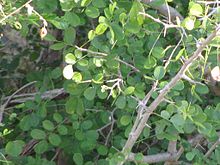Dalbergia melanoxylon (African blackwood, grenadilla, or mpingo) is a flowering plant in the family Fabaceae, native to seasonally dry regions of Africa from Senegal east to Eritrea and south to the Transvaal in South Africa. The tree is an important timber species in its native areas; it is used in the manufacture of musical instruments and fine furniture. Populations and genomic resources for genetic biodiversity maintenance in parts of its native range are threatened by over harvesting due to poor or absent conservation planning and by the species' low germination rates.
It is a small tree, reaching 4–15 m tall, with grey bark and spiny shoots. The leaves are deciduous in the dry season alternate, 6–22 cm long, pinnately compound, with 6-9 alternately arranged leaflets. The flowers are white and produced in dense clusters. The fruit is a pod 3–7 cm long, containing one to two seeds.
Uses
The dense, lustrous wood, ranges from reddish to pure black. It is generally cut into small billets or logs with its sharply demarcated bright yellow white sapwood left on to assist in the slow drying so as to prevent cracks developing. Good quality "A" grade African blackwood commands high prices on the commercial timber market. The tonal qualities of African blackwood are particularly valued when used in woodwind instruments, principally clarinets, oboes, transverse flutes, piccolos, Highland pipes and Northumbrian pipes. The timber is used mainly because of its machinability and dimensional stability. Deering Banjo Company uses blackwood ("grenadilla") to construct the tone ring in its John Hartford model banjo. Deering indicates that this reduces weight versus brass/bronze tone rings, and that the wood "plays in" (improves in tone) with use. Furniture makers from the time of the Egyptians have valued this timber. A story states that it has even been used as ballast in trading ships and that some enterprising Northumbrian pipe makers used old discarded blackwood ballast to great effect. The German knife company Wüsthof [Zwilling J. A. Heckles] has also begun to sell a series of knives with blackwood handles due to the wood's moisture repellent qualities. Gresso, a cell phone manufacturer based in Russia, recently began selling luxury cell phones whose casing is made from African blackwood.
Due to overuse, the mpingo tree is severely threatened in Kenya and is needing attention in Tanzania and Mozambique. The trees are being harvested at an unsustainable rate, partly because of illegal smuggling of the wood into Kenya, but also because the tree takes upwards of 60 years to mature.
Relation to other wood- African blackwood is no longer regarded as ebony, a name now reserved for a limited number of timbers yielded by the genus Diospyros: these are more of a matte appearance and are more brittle.
- The genus Dalbergia yields other famous timbers such as Brazilian rosewood (Dalbergia nigra), Dalbergia cearensis and cocobolo (Dalbergia retusa).
Other names by which the tree is known include babanus and grenadilla, which appear as loanwords in various local English dialects.
Conservation
There are multiple organisations involved in the conservation of African blackwood: the Mpingo Conservation & Development Initiative, the African Blackwood Conservation Project, and Clarinets for Conservation.
The Mpingo Conservation & Development Initiative (MCDI, formerly the Mpingo Conservation Project) is involved in research, awareness raising and practical conservation of African blackwood. Conservation of Mpingo and its natural habitat can be achieved by ensuring that local people living in mpingo harvesting areas receive a fair share of the revenue created, thus providing them with an incentive to manage the habitat in an environmentally friendly manner. In order to achieve this, the MCDI is helping communities to get Forest Stewardship Certification.
The African blackwood Conservation Project works around Mount Kilimanjaro replanting African blackwood trees, and in conservation education. It also works with adult and women's groups in the promotion of environmentally sound land uses
Clarinets for Conservation is based in Moshi, Tanzania and aims to raise awareness and promote conservation of Mpingo through music education. Students participate in an interdisciplinary program during the summer months that raises awareness of the value of Mpingo through musical performances, classroom instruction, and tree plantings at local secondary and primary schools.
Small growers in Naples, Florida, have been successful in growing African blackwood there. Growth habit in Florida yields taller, larger trees, and the rich soil combined with ample nutrients and long growing season yields timber of superior quality at more sustainable rates. Hopefully, ventures like this will be able to take strain off African reserves and allow this timber to be used in the future.
Footnotes- ^ The Plant List: A Working List of All Plant Species, retrieved 12 December 2015
- ^ a b Amri, E.; Z.L. Kanyeka; H.V.M. Lyaruu; A.S. Nyomora (2009). "Evaluation of genetic diversity in Dalbergia elanoxylon populations using random amplified polymorphic DNA markers". Research Journal of Cell and Molecular Biology (INSInet Publication) 3 (2): 71–79.
- ^ Most Expensive Wood. June 22, 2009
- ^ World's Most Expensive Cell Phones. October 11, 2010
- ^ "Welcome". Mpingo Conservation & Development Initiative. Retrieved 2013-07-07.
- ^ "Home". African Blackwood Conservation Project. Retrieved 2013-07-07.
- ^ "Our Mission". Clarinets for Conservation. Retrieved 2013-07-07.
- World Conservation Monitoring Centre (1998). Dalbergia melanoxylon. 2006. IUCN Red List of Threatened Species. IUCN 2006. www.iucnredlist.org. Retrieved on 11 May 2006.
- ARKive - images and movies of the African blackwood (Dalbergia melanoxylon)
- Tanzania: Protecting the World's Most Expensive Tree
- FAO factsheet
- Winrock Forestry factsheet
- Global Trees factsheet
- Mpingo conservation
- Sustainable Blackwood - the Sound and Fair campaign
- Some facts about the wood
- Direct source for local Mozambican African Blackwood
- ENVIRONMENT-TANZANIA: Protecting the World's Most Expensive Tree
- Online source for Mozambican African Blackwood
- Dalbergia melanoxylon, in West African plants – A Photo Guide.
- Wikipedia








No comments:
Post a Comment